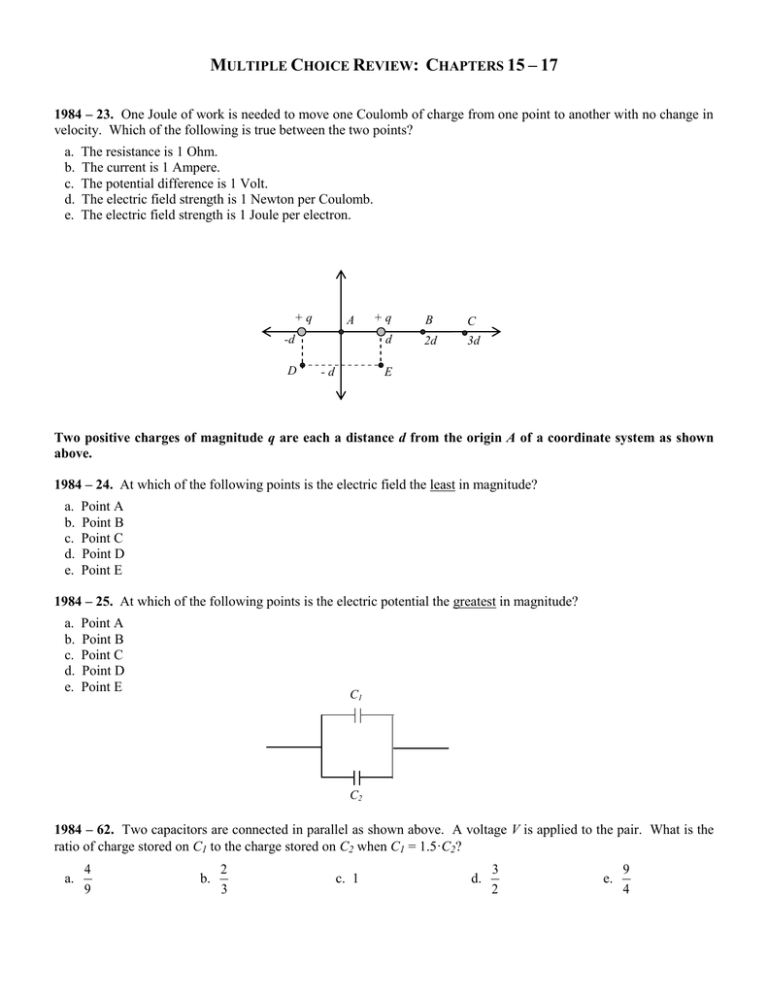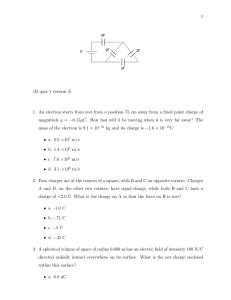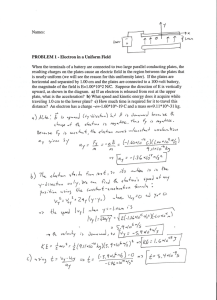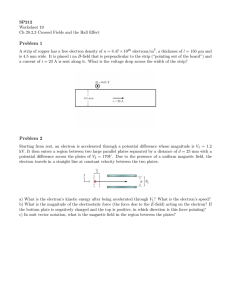MULTIPLE CHOICE REVIEW: CHAPTERS 15 – 17
advertisement

MULTIPLE CHOICE REVIEW: CHAPTERS 15 – 17 1984 – 23. One Joule of work is needed to move one Coulomb of charge from one point to another with no change in velocity. Which of the following is true between the two points? a. b. c. d. e. The resistance is 1 Ohm. The current is 1 Ampere. The potential difference is 1 Volt. The electric field strength is 1 Newton per Coulomb. The electric field strength is 1 Joule per electron. +q A -d D +q d -d B C 2d 3d E Two positive charges of magnitude q are each a distance d from the origin A of a coordinate system as shown above. 1984 – 24. At which of the following points is the electric field the least in magnitude? a. b. c. d. e. Point A Point B Point C Point D Point E 1984 – 25. At which of the following points is the electric potential the greatest in magnitude? a. b. c. d. e. Point A Point B Point C Point D Point E C1 C2 1984 – 62. Two capacitors are connected in parallel as shown above. A voltage V is applied to the pair. What is the ratio of charge stored on C1 to the charge stored on C2 when C1 = 1.5·C2? a. 4 9 b. 2 3 c. 1 d. 3 2 e. 9 4 FREE RESPONSE REVIEW: CHAPTERS 15 – 17 30 E E 30 Diagram 1 Diagram 2 1981 – 3. A small conducting sphere of mass 5 x 10-3 kg, attached to a string of length .2 m, is at rest in a uniform electric field E, directed horizontally to the right as shown in Diagram 1 above. There is a charge of 5 x 10-6 C on the sphere. The string makes an angle of 30 with the vertical. (a) Draw and label all the forces acting on the sphere. (b) Calculate the tension in the string. (c) Calculate the magnitude of the electric field. (d) The string now breaks, as shown in Diagram 2 above. Describe the subsequent motion of the sphere and sketch the path of the sphere while in the electric field. y +a -2Q -Q O x 2a -a -2Q 2005B – 3. The figure above shows two point charges, each of charge –2Q, fixed on the y-axis at y = +a and at y = -a. A third point charge of charge –Q is placed on the x-axis at x = 2a. Express all algebraic answers in terms of Q, a, and fundamental constants. (a) Derive an expression for the magnitude of the net force on the charge –Q due to the other two charges, and state its direction. (b) Derive an expression for the magnitude of the net electric field at the origin due to all three charges, and state its direction. (c) Derive an expression for the electrical potential at the origin due to all three charges. (d) A fourth charge –3Q is brought from a very distant point by an external force and placed at the origin. Derive an expression for the work required for this process. FREE RESPONSE REVIEW: CHAPTERS 15 – 17 (CONT) .04 m .50 m Electron Beam .012 m Screen Note: Figure not drawn to scale. 1999 – 2. In a television set, electrons are first accelerated from rest through a potential difference in an electron gun. They then pass through deflecting plates before striking the screen. The pair of horizontal plates shown above is used to deflect electrons up or down in the television set by placing a potential difference across them. The plates have length 0.04 m and separation 0.012 m, and the right edge of the plates is 0.50 m from the screen. A potential difference of 200 V is applied across the plates, and the electrons are deflected toward the top of the screen. Assume that the electrons enter horizontally midway between the plates with a speed of 6.0 x 107 m/s and that fringing effects at the edges of the plates and gravity are negligible. (a) Prior to entering the deflecting plates, the electrons are accelerated in an electron gun. Determine the potential difference through which the electrons must be accelerated in the electron gun in order to have a speed of 6.0 x 107 m/s when they first enter the deflecting plates. (b) Which plate in the pair (upper or lower) must be at the higher potential for the electrons to be deflected upward? Justify your answer. (c) Considering only an electron's motion as it moves through the space between the plates, compute the following: i. The time required for the electron to move through the plates. ii. The vertical displacement of the electron while it is between the plates. (d) Neglecting gravity, describe the path of the electrons from the time they enter the plates until they strike the screen. State a reason for your answer.




